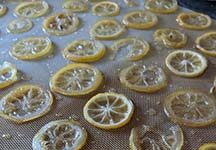Amanda Miller
Columnist
Lettuce Eat Local
We all know it’s dangerous to say we’ll “never” do something — we know the chances are very high that at some point we’ll find ourselves doing that very thing. I shouldn’t be surprised then that last week I had to eat my words (literally and figuratively) in regards to sandhill plum jelly.
It’s been years since I decided I’m never making sandhill plum jelly. Since I’m not a Kansas native, I didn’t grow up familiar with this regional specialty, and it has no draw for me whatsoever. It’s fine and all; I definitely don’t dislike it, but the response it elicits from me is merely a noncommittal shrug.
Heresy, I know. And here I call myself a Kansan.
I have debated the issue with myself, so it’s not that I haven’t made an informed decision. Sandhill plum jelly comes with a whole list of pros and cons. To its defense, these native plums grow wild and are forageable here in our sometimes-disagreeable climate, which is something I deeply appreciate. As big bonuses, the bushes provide windbreaks and shade, and are very effective at erosion control. The tart little fruits, also called chickasaw plums or mountain cherries in other Midwestern regions, are bright red pops of color for our dusty prairies, and that color transfers to the jars of jelly in a distinctly gorgeous hue.
Now for the cons. See where I said “tart little” fruits? I meant that part, and while there is some variation on the level of both qualities, often those adjectives should be more drastic. Read, “mouth-puckering, teeth-hurting itsy-bitsy teeny-weeny” fruits. We have a few bushes out by a pasture, and I’m being generous if I call them the size of a good blueberry; the minimal bits of flesh that cling to their substantial pits are as sour as a lemon. And while the branches of those soil-stabilizing bushes are loaded with plums, they are also spiky and unfriendly.
So in addition to needing about 1000 plums for a batch, I’d also have to actually make jelly — another thing I don’t do. Technically this may have been the first time I’ve made strained jelly, because even jam and I have a relationship fraught with distrust. It’s a lot of work for something laden with sugar that we will probably never remember to eat…and with my luck (/lack of precision), it won’t set anyway.
So for years now, I’ve been comfortable in my disregard for sandhill plum jelly.
That all changed when a friend asked if I would do the jelly part if she picked the plums that were too big and plentiful for her to resist. I love canning so much that suddenly it was also too much for me to resist, and I (happily albeit trepidatiously) agreed.
And what do you know, it wasn’t that hard or tedious, and the jelly set beautifully with such an appealing flavor and color. Benson and Brian both have eaten a significantly higher amount of bread recently since there’s an open jar of jelly in the fridge. The batch made more jelly than anticipated, so I have half a dozen jars for myself, and I’m thrilled about being able to share them — both with people who know and love sandhill plum jelly, and those who’ve never heard of it. I already sent a jar to my parents in Ohio, so we’ll see if their reaction is like my guys who basically race each other to finish their jelly bread so the other one can’t sneak it, or whether it’s closer to the shrugged shoulders I used to give.
I say “used to,” because I’m having to seriously rethink my jelly convictions. Maybe, even if it’s not my jam, I’ll make sandhill plum jelly again some summer.
Sandhill Plum Jelly
I was surprised to find no sandhill recipe in my local church cookbooks, but fortunately I have other reputable sources for such things. My friend who makes it often shared her method, and I have no complaints. Except for the amount of sugar, although it must be correct, because this jelly is just right: neither too sweet nor too sour. We might be past most of sandhill plum season, but our sorry bushes still have a bunch hanging on (because no one cares to pick them…), so you might still be able to find some around. If you need more specific canning instructions, please don’t wing it — look up a credible resource or email me with questions (if you consider me credible).
Prep tips: If you don’t want to make the jelly the same time as you pick the plums, just wash them and pop them in the freezer! I think it actually helps to break them down, and this way the work is broken up into stages and isn’t overwhelming.
5 lb sandhill plums
4 cups water
1 box pectin
8 cups sugar
Cook plums with water in a large kettle, simmering until they are super soft and easily smushed when pressed; let cool somewhat. Drape four layers of cheesecloth in a strainer set over a bowl, and let plums drain for half an hour or so before squeezing and getting more juice out. You’ll probably need to do this in several batches, and don’t squeeze so hard that you get pulp through or the jelly will be bitter. You should get about 6 cups of liquid — if you get more than that, reserve the extra for something else.
Heat those 6 cups of juice, and thoroughly stir in the box of pectin. Bring to a rolling boil, then thoroughly stir in the sugar. Bring back to a rolling boil, and boil for exactly 1 minute, stirring the whole time. Remove from heat, ladle into half-pint jars, and water-bath process for 6 minutes.



